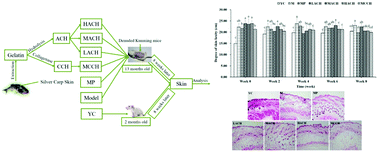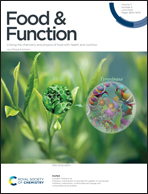Ingestion of collagen hydrolysates alleviates skin chronological aging in an aged mouse model by increasing collagen synthesis
Abstract
Although the use of collagen hydrolysates (CHs) as nutraceutical agents to protect skin against photoaging has been widely investigated, little is known about their effects on skin chronological aging and the underlying mechanism. Nutritional supplementation, such as collagen and related hydrolysates, might have beneficial effects on chronologically aged skin just as on photoaged skin. Hence, 13-month-old female Kunming mice ingested CHs for eight weeks to evaluate the effects of CHs on ameliorating skin chronological aging. CHs were enzymatically prepared using alcalase or collagenase, named ACH and CCH, respectively. The results showed that CHs or proline intake had no obvious effects on skin moisture and hyaluronic acid contents. However, ACHs significantly decreased skin laxity, increased collagen I content, normalized the ratio of collagen I/III and repaired dermal collagen fibers in a dose-dependent manner. At an identical dose, ACH showed an advantage over CCH or proline in significantly increasing collagen I content. Further study indicated that CHs mainly improved skin condition by activating the transforming growth factor β (TGF-β)/Smad signaling pathway to promote the synthesis of collagen I rather than inhibiting collagen I degradation by deregulating activator protein-1 (AP-1). The results indicated that CHs could benefit skin in both extrinsic and intrinsic aging as active dietary supplements.



 Please wait while we load your content...
Please wait while we load your content...